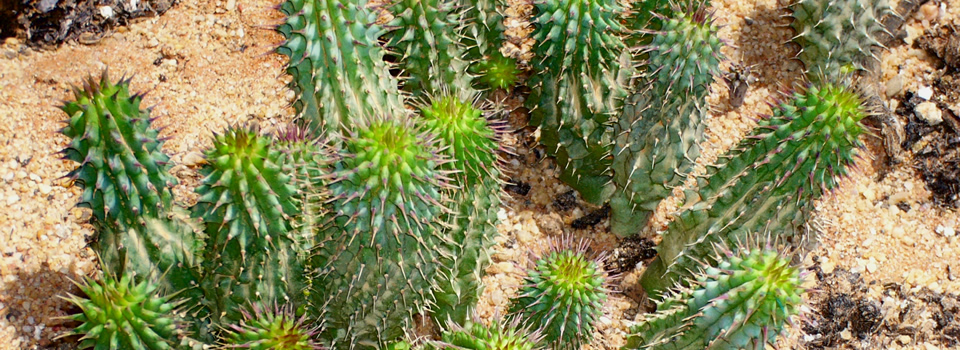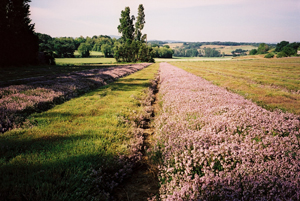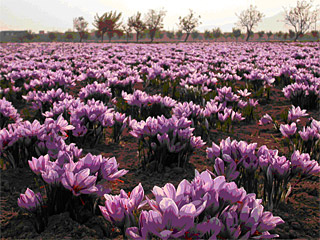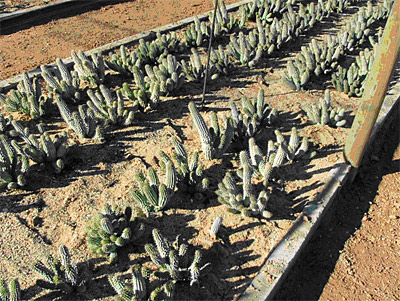 Currently two medicinal plants with a long tradition of use conquer the Western markets: Saffron, the stigmates of Crocus sativus, and Hoodia sp., a South African cactus-like Asclepiadaceae. Saffron was highly estimated by Arabian, Persan, Roman and Greek health authorities for its cardiotonic, anti-inflammatory, liver protective, stimulant and aphrodisiac effects. In modern pharmacological research, adaptogenic, antidepressant and cancer-protective effects were evidenced.
Currently two medicinal plants with a long tradition of use conquer the Western markets: Saffron, the stigmates of Crocus sativus, and Hoodia sp., a South African cactus-like Asclepiadaceae. Saffron was highly estimated by Arabian, Persan, Roman and Greek health authorities for its cardiotonic, anti-inflammatory, liver protective, stimulant and aphrodisiac effects. In modern pharmacological research, adaptogenic, antidepressant and cancer-protective effects were evidenced.
Hoodia has a long tradition in Bushmen societies of the Kalahari, who used the stems of Hoodia as a source of water, but also to fight the feeling of hunger. Phytochemical and pharmacological testing led to the discovery of a fraction of triterpene saponins with marked hunger suppressing effect, which makes preparations from Hoodia an innovative and promising tool for the treatment of obesity, diabetes type II, and overweight-related cardiovascular disorders (e.g. metabolic syndrome).

 Although the use of Hoodia preparations is protected by an US-American patent in many countries, the grey markets are flooded with Hoodia products of highly questionable quality. Hoodia and saffron are both very expensive and relatively rare raw materials, which is displayed in a wide range of adulterations. The current situation does not encourage the systematic use of uncontrolled raw material, especially since scientific results obtained with such material cannot be expected
Although the use of Hoodia preparations is protected by an US-American patent in many countries, the grey markets are flooded with Hoodia products of highly questionable quality. Hoodia and saffron are both very expensive and relatively rare raw materials, which is displayed in a wide range of adulterations. The current situation does not encourage the systematic use of uncontrolled raw material, especially since scientific results obtained with such material cannot be expected
to be reproducible. A simple solution to make the wealth of traditional medicinal experience available to science and modern medicine is to follow the rules of the WHO guideline „Good Agricultural and Collection Practice” (GACP), and to establish a complete traceability of the raw material.
A simple solution to make the wealth of traditional medicinal experience available to science and modern medicine is to follow the rules of the WHO guideline „Good Agricultural and Collection Practice” (GACP), and to establish a complete traceability of the raw material.
Our international research program focuses on the screening of suitable cultivars and controlled cultivation as well as on phytochemical, pharmacological and clinical research on both plants. It also includes the galenical development of extracts.
Download: Symposium on Medicinal Plant Research, Amman (Jordan), November 16-18, 2005
 Quality and safety are not only key issues of licensed drugs, but also of nutritional supplements, especially when these are produced from herbal starting materials.
Quality and safety are not only key issues of licensed drugs, but also of nutritional supplements, especially when these are produced from herbal starting materials.
New guidelines affecting the collection of herbal plant raw material are currently being implemented within the EU countries. EC directives 178/2002/EC and NTA Vol 2B Ed. July 2003 regulate the traceability of herbal raw materials for food and drug use, and the WHO guideline “Good Agricultural and Collection Practice” is defining the rules by which the herbal material should be collected. Both guidelines, traceability and collection practice, should lead to total transparency of the whole chain of production of most herbal medicines from the plant down to the finished product.
So far the theory. In practice, most herbal raw materials are still harvested or wild crafted under completely uncontrollable conditions. The risk of adulteration is not only a question of economic fraud, it is directly related to product safety. Even if a given herb can be considered as safe, the adulterants may not be harmless.
Properly applied, the WHO GACP guideline serves many good purposes:
- Unambiguous botanical identification of herbs
- Selection of cultivars tailored to the use of the final product
- Decreasing danger of adulterations, and thus of accidental toxicity
- Amelioration of the reproducibility of the clinical effects of herbal medicines
- Protection of the environment.
Herein, we want to present two examples for the improvement of the quality and safety of herbs: Saffron and Hoodia.
 Saffron is one of the most expensive spice and medicinal plants existing. This situation has invited fraudulent behaviour since antiquity. Typical adulterants are tiny red-coloured paper strips, fibres from dried meat, strips of anilin dyes, cut flowers from Calendula or other red to orange species, or even pre-extracted and re-dried stigmates. In a recent study of the “Direction générale pour la repression des fraudes” 102 samples of commercial saffron were examined. From these 102 samples, 85 (corresponding to 83.3 %!) turned out to be adulterated. This situation is likely to have consequences for the safety of application.
Saffron is one of the most expensive spice and medicinal plants existing. This situation has invited fraudulent behaviour since antiquity. Typical adulterants are tiny red-coloured paper strips, fibres from dried meat, strips of anilin dyes, cut flowers from Calendula or other red to orange species, or even pre-extracted and re-dried stigmates. In a recent study of the “Direction générale pour la repression des fraudes” 102 samples of commercial saffron were examined. From these 102 samples, 85 (corresponding to 83.3 %!) turned out to be adulterated. This situation is likely to have consequences for the safety of application.
Our project was aimed on the selection of high performance cultivars according to the needs of the producers of saffron-containing products. We were able to select cultivars optimized for various uses (e.g., more stimulant or more chemopreventive), and to perform agricultural research programs on the optimization of Crocus propagation and harvesting time.
We have established a GMP conform and fully traceable production of saffron with full analytical control. Only recently, we developed a standardized liquid extract and methods for its transformation into dry extracts, including stability testing. We are currently involved in a pharmacologic and phytochemical research program on saffron.
 Hoodia gordonii is a plant native to Southern Africa. Its growth characteristics remind of a cactus, it is, however, a succulent member of the family of Asclepiadaceae.
Hoodia gordonii is a plant native to Southern Africa. Its growth characteristics remind of a cactus, it is, however, a succulent member of the family of Asclepiadaceae.
Lately, Hoodia has gained worldwide attention through the discovery of appetite suppressant effects. The subsequent Hoodia boom has rapidly led the plant to the edge of extinction through destructive wild collection and overharvesting. With the rarification came the adulterations. A huge percentage of products currently on the market is adulterated, especially in the United States, where additions of cheap Opuntia powder were detected in Hoodia products, next to unknown replacements.
The obvious solution consisted in the organisation of a controlled cultivation of Hoodia, which, however, is no easy task. The slow growth of the herb warrants a good planning ahead.
We have now achieved:
- an implementation of a controlled cultivation of saffron and Hoodia with full traceability;
- the initiation of botanical and phytochemical screenings of related species and cultivars of saffron and Hoodia;
- stability testing of saffron extract;
- methods for an antibacterial treatment without the use of gasses or irradiation; and
- the development of different galenical forms of saffron extract.
We are currently preparing the pharmacological testing of saffron and new analytical standards for Hoodia.

